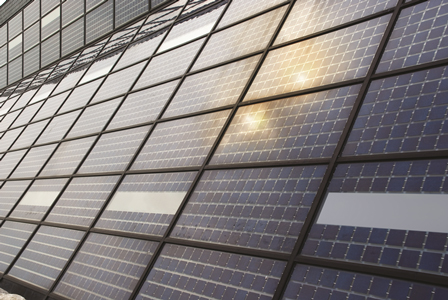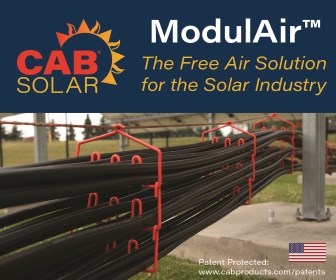Weighing Costs vs. Performance: Backsheet considerations for solar modules
 The composition of photovoltaic backsheets has evolved from the early days of PV module manufacturing that, over time, has resulted in products that offer reliable performance at a more cost-effective price point. Original backsheet constructions contained multiple fluoropolymer layers. These products offered weather and UV protection, but were expensive, as they primarily utilized Tedlar in their construction. Tedlar is far more durable than other plastics, and easily provided for the weather and water/vapor resistance required by the solar industry.
The composition of photovoltaic backsheets has evolved from the early days of PV module manufacturing that, over time, has resulted in products that offer reliable performance at a more cost-effective price point. Original backsheet constructions contained multiple fluoropolymer layers. These products offered weather and UV protection, but were expensive, as they primarily utilized Tedlar in their construction. Tedlar is far more durable than other plastics, and easily provided for the weather and water/vapor resistance required by the solar industry.
The introduction of alternatives in the marketplace, such as Kynar, provided some choices to help drive the costs of PV backsheets down. With the falling prices of panels, however, market pressures were strong, eventually resulting in design changes altogether. Today, a variety of PV backsheet constructions are available to choose from. Options are nice to have, but selecting the best backsheets for a solar power project is key.
Selection criteria for these materials are: performance, availability, and cost. The differences might seem subtle, but the right choice can help save time and money, while ensuring that the photovoltaic panels utilized offer reliable performance over time.
A historical perspective
First developed for residential siding in the early 1960’s, DuPont’s Tedlar (polyvinyl fluoride) was the original film of choice for backsheet construction. Its proven history of performance in demanding indoor and outdoor applications quickly pushed it to the forefront where it became the preferred choice for backsheet film, complete with a reassuring 25-year warranty.
In the original backsheet construction, Tedlar was the “bread” of a two-layer material sandwich—two layers of Tedlar fluoropolymer film flanking one layer of polyester (PET) in the middle. Eventually, the two layers became regarded as a highly engineered and overly expensive product design. So, with fluoropolymer being the most expensive layer in backsheet construction, and Tedlar becoming increasingly difficult to obtain, designers turned to other options. These options included a single layer of fluoropolymer, as well as non-fluoropolymer designs.
A fluoropolymer called Kynar (polyvinylidene fluoride) became a popular alternative to Tedlar, offering equal performance without the supply constraints. The availability of Kynar film, in double and single fluoropolymer constructions, made it especially attractive in the solar industry.
As a result of an ongoing effort, a non-fluoropolymer backsheet alternative using polyester and EVA has also gained acceptance for its adequate performance and greater affordability.
Innovation & evolution
The goal of a backsheet is to provide modules with UV and moisture protection, electrical insulation, and some degree of durability. Technology advances, coupled with changes in IEC standards, have increased backsheet requirements. Electrical insulation performance was mandated to pass 1000 VDC partial discharge, which meant a minimum backsheet thickness of ~300 mm.
Today, it’s common for manufacturers to test beyond the 1000-hour damp heat requirement, thereby placing greater importance on the durability of laminating adhesives. As the current demand for backsheets has increased, the need for even lower costs and higher durability has intensified.
As a result, design engineers can select from three different types of backsheet material constructions, as follows:
1. Double fluoropolymer
The original backsheet component construction remains available, but is still at the top of the price scale. Double fluoropolymer is now typically offered as either double layers of Tedlar, or double layers of Kynar. The two polymers are similar in their exceptional performance.
2. Single fluoropolymer
Developed as a more affordable option, single fluoropolymer still provides excellent performance and durability with just one layer of Tedlar or Kynar. It has quickly become the construction of choice for the majority of applications, considering the price per performance.
3. Non-fluoropolymer
The most affordable option to date is non-fluoropolymer, which has steadily grown in popularity as module manufacturers migrate to more and more cost-effective alternatives. Non-fluoropolymer is not only economical, but it provides sufficient performance and the ability to support varying warranties.
With the evolution of polymeric solutions, there are now an increasing number of backsheet options for photovoltaic projects. Backsheet materials have come a long way over the years, and today’s manufacturers are more dedicated than ever to staying ahead of market demands by delivering new, innovative product offerings to meet their customers’ needs and budgets.
Bruce Beaupre is the market development specialist at FLEXcon. FLEXcon is an ISO 9001:2008 certified manufacturer of pressure-sensitive films and adhesives. They are a global supplier of solar module backsheet solutions for the PV industry.
FLEXcon
www.flexcon.com
Author: Bruce Beaupre
Volume: November/December 2014









.png?r=4328)


